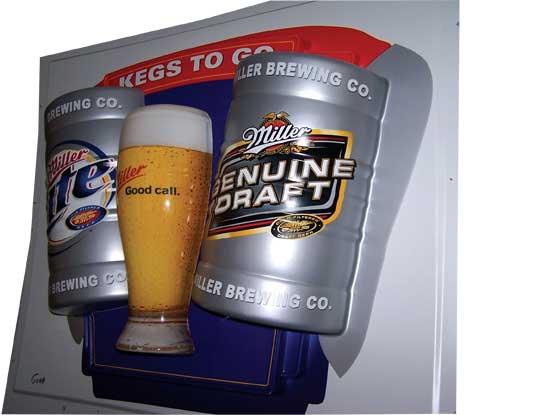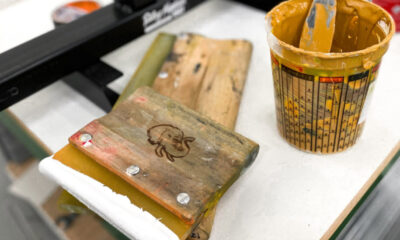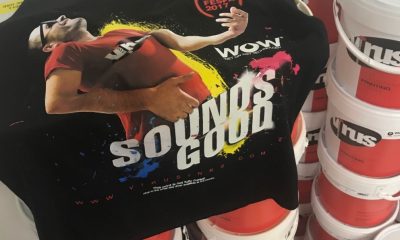Inks & Coatings
Published
13 years agoon

As the digital industry continues to develop, can the presses and the inks really keep up with the demands—or with our imaginations?
New ink systems and applications are plunging the digital industry into markets that, until now, were considered off limits. With continued technological advances in UV chemistries, digital inks are continuing to evolve at a staggering pace. These new UV systems are setting performance standards that once were considered almost impossible, providing improved color gamut, cure speeds, substrate versatility, and durability.
As the digital industry continues to develop, can the presses and the inks really keep up with the demands—or with our imaginations?
New ink systems and applications are plunging the digital industry into markets that, until now, were considered off limits. With continued technological advances in UV chemistries, digital inks are continuing to evolve at a staggering pace. These new UV systems are setting performance standards that once were considered almost impossible, providing improved color gamut, cure speeds, substrate versatility, and durability.
Historically, research chemists had a limited selection of raw materials to work with when developing UV inkjet inks. Today, myriad raw materials contribute to the functionality of these ink systems in ways never before thought possible. Raw-material manufacturers and suppliers have committed all resources available to the continued development of this growing market, and ink-formulation chemists are the beneficiaries. The relationship between raw-material manufacturers and the formulation chemists is vital in the development of these high-performance digital ink systems.
In this article, we look at the latest UV digital inks and their relationship to UV screen inks. We delve into how this newest generation of ink systems must be formulated to overcome limitations in conventional UV digital performance. Given the cutting-edge menu of monomers, oligomers, photoinitiators, additives, and pigment dispersions, there should be no limit to the application of these inks to new markets and materials.
Mission: nothing’s impossible
The future of digital ink is limited only by our imagination. I anticipate we will see digitally printed dashboard clusters in vehicles, improved printing of architectural glass, jettable adhesives and metallics, in-mold decorations for blow molding and injection molding, digitally printed membrane switches and electronic circuitry, and more.
Can we do it now? Not yet, or at least it’s not ready for prime time. But we’ll get there with the help of open-minded researchers and raw-materials suppliers. Constant communication between ink manufacturers and their suppliers creates the chemical building blocks for these ink systems.
But the story was much different in the 1990s. Raw-materials manufacturers at the time, even the largest in the market, said they couldn’t supply certain components or that particular ideas, such as providing inks with enough elongation for the screen print vacuum-forming process, could never come to fruition. But we did it and today’s situation is much different. Let’s take a look at the building blocks of screen and digital inks and then examine the changes that have shaped the specialty formulations that were supposed to be impossible to create.
Ink foundations
All screen inks begin with the same set of components: monomers, oligomers, resins, initiators, pigments, and additives. These also happen to be the same components needed for digital. So what’s different?
Monomers This component makes up the majority of the ink system and is the basic building block of UV ink. It is a small molecule that may become chemically bonded to other monomers to form a polymer. Monomers have different levels of functionality that allow them to perform in different ways. Functionality describes the component’s adhesion range. Monofunctional adheres like a joystick—one gripping point. It promotes elongation (Figure 1). Di-, tri-, and multifunctional monomers have multiple gripping points, much like a hook-and-loop fastener. They go on glass and metal—rigid materials. Monomers enhance cure speed, improve adhesion, and adjust viscosity.
Oligomers This is a molecule or chemical compound of a complicated structure consisting of several monomeric units in chemical union. It is the base resin used in UV-ink formulations. Oligomers are the backbone of the screen-ink system. Oligomer selection is based on required adhesion, the need for flexibility or a harder surface, or level of lightfastness. They include urethane, polyester, epoxy, and acrylic. Oligomers tend to be of high viscosity, and need to be refined and their proportions limited in inkjet inks.
Resins These are a category of thermoplastic or thermosetting polymers or co-polymers of acrylic acid, methacrylic acid, esters of these acids, or acrylonitrile used to produce paints, synthetic rubbers, and lightweight plastics. Resins are generally inert components that help with adhesion and surface characteristics. Typically, only small amounts of resins are used in digital inks because of their high molecular weight.
Initiators Photoinitiators absorb UV energy from a light source, setting in motion a chemical reaction that quickly polymerizes and converts the liquid into a solid. Ultimately, initiators serve as spark plugs that cause crosslinking throughout the ink system. Ink manufacturers use a multitude of initiators, depending on the nanometer range at which they want the ink system to cure.
Additive package An additive is any chemical added to an ink to change the characteristics of the ink, such as cure speed, adhesion, or chemical or water resistance, to name a few. Screen inks contain additive packages that can include thickening powders, flattening powders, or flow controls that promote a smooth flow without surface imperfections. Additives also can provide specialty finishes in screen inks that are not yet available in inkjet inks. The flow-control and wetting agents used in digital inks tend to be in liquid form with a sub-micron particle size.
Pigments These are fine, solid particles used to give color, transparency, or opacity. They may be made of organic or inorganic materials, and they are grouped according to color using a color index and a grayscale rating of 1-8 (8 being the most lightfast or durable). They possess different properties of lightfastness, and they also can have similar properties to oligomers, including chemical resistance, heat and cold resistance, abrasion resistance, and more. Pigments tend to raise the viscosity of inkjet inks. For digital inks, manufacturers are now chemically treating pigments to help them break down before they go through the milling process. The pigment particulates are then milled down to a sub-micron size.
Turning peanut butter into a fine wine
Screen-printing ink can be compared to mayonnaise or even peanut butter in terms of thickness or viscosity. As a point of reference, screen-printing inks can range from 1,500- 19,000 centipoises. Digital inks, for the most part, are around 10-20 centipoises in viscosity. As a benchmark, water measures 0-2 centipoises—a huge difference in itself. Manufacturers have to reduce particle size to smaller than 1 μm to fire inks through inkjet printheads (Figure 2). This involves looking at raw materials that don’t have anything to do with the screen-printing industry but affect the physical characteristics of a fluid or ink system. The process also involves transferring the technology to digital—making a chocolate bar into chocolate milk.
The process requires raw materials suppliers to become completely open minded about the new components needed to reduce viscosities and gain functionalities for new inkjet-ink systems. Ink formulators must address the shortcomings of early generations of digital inks by experimenting with newly upgraded components and by requesting or designing entirely new ones. They must look into newly created components, regardless of whether the suppliers think they need it at the moment
What about taking some of the components of a digital ink and reverse engineering them to make screen-printing ink? Experimentation in this area can result in an entirely new generation of screen functionalities and properties. Such discoveries would never have been made had manufacturers not been forced to reduce the viscosity of screen ink to create digital ink. While the advances in digital printing have broken the barriers into the screen-printing market, we must not surrender to it. Screen will always have its place. Some of the most powerful and successful screen printers that I visit have managed to successfully integrate digital with screen to gain capacities and efficiencies that set them apart.
New markets
Innovations in UV ink will enable digital printing to have a profound impact on a variety of new markets, some of which are identified below.
In-mold decorating Digitally produced electronics clusters are being introduced, but only on a limited basis. This certainly leaves room for improvement, while screen printing continues to be a favorite choice—by the hundreds of thousands. The resolution, tolerance, and quality needed for this market remains an ongoing challenge for the digital-printing arena. While advances in digital presses and ink technology are ongoing, the post-print processing creates tremendous friction, elongation, and heat—up to 700°F. This is an environment in which few inks can survive. It continues to pose a challenge for digital ink systems.
The automotive industry wants the short-run capability of digital printing. Years ago, manufacturers would print 250,000 dash clusters for any given model each quarter. Now, those same purchase orders might be 2,500 or 700—or less. The end users of these clusters would love to have manufacturing and supply on demand. Digital allows them to make 20 of these in a row. The shape and size could be different, and the text could be Russian, Spanish, or French—all with no set-up time or waste. This is a massive market that includes cell phones, electronics, stereos, computers, toys, and house wares like table tops and containers.
Architectural glass Glass is a beast. It’s heavy, robust, and chemically resilient—not exactly an ink’s best friend. However, with continued advancements in technology and surface treatments that will allow the inks to adhere on a microscopic level, this market will continue to grow and flourish.
Metallic digital printing While a true UV metallic digital ink remains evasive, considerable advances are ongoing. There are several solvent-based digital systems that have the luster and sheen, but they lack the depth of a true metallic. Currently, these true metallic inks are printed with screen, litho, flexo, or other ink-to-substrate processes. Typical metallic particles are too large to go through microscopic openings in digital printheads. Most metallic pigments are 20 times too large, and once they are refined to a sub-micron size, suitable for jetting, their weight causes them to settle or drop out of suspension, which necessitates the use of higher viscosity dispersants all while keeping the viscosity below 20 centipoises. This, my friends, is the challenge of the day!
Jettable adhesives Adhesives are all around us, and each of us comes in contact with some sort of an adhesive every day, throughout the day. They literally hold our world together, and we take them for granted. Adhesives can be applied using a variety of methods, including screen printing, painting, spraying, and various roll-coat applications. They can stay tacky. There are heat-activated adhesives, cohesives, solvent-activated and water-activated adhesives, just to name a few. Usually, the adhesive is applied after printing, regardless of its purpose.
Digitally applied, jettable adhesives for the industrial digital market will allow digital printers to selectively jet adhesives to packing cartons, displays, and permanent or temporary graphics. In the P-O-P market, such digital adhesives will allow printers to apply a selective adhesive patch at the same time they are printing a graphic. There will be applications for multilayered, multidimensional displays. Digital adhesives will allow printers unlimited design capabilities that will provide unrestricted creative freedom for both designers and printers.
Membrane switches and electronic circuits Like dash clusters, membrane switches are printed in high volumes. They require very close tolerance and pin-point repeatability. These membranes require multiple layers and can include insulators and conductive layers that, in the end, represent the message center of a given electronic device. It is logical that digital printing will ultimately play an important role in the future of the membrane market and its efficiencies. It goes without saying that digitally printed electronic circuitry will be a massive market in the future.
Refined color gamut Ink developers and manufacturers are always refining the color gamut or the overall spectrum of color and how we perceive it. New software, new color theories, and new head and press configurations all influence the final image and its richness and accuracy of color. As firing patterns, nozzle velocities, and head-assembly travel speeds increase, so must the ink system that is fired through them (Figure 3).
Astounding advancements in all aspects of digital technology have come about in a very short period of time. That which was once considered a tool for short runs, prototyping, or the infamous one-off run, is now a story of the past. Digital presses are becoming faster, more efficient, and more versatile. As screen printing, litho, offset, gravure, and digital printing continue to collide, it is very important that an inexhaustible amount of research and development continues in all aspects of the printing industry. And with the advancements of hardware, software, firmware and chemistry taking place right now, all of us are in for a wild and exciting ride.
Mike Plier is president of Polymeric Imaging, Inc., a manufacturer of UV inks and coatings formulated for high performance. He has more than 30 years of experience in the printing industry, including imaging, production, processing, and substrates.

Subscribe

Magazine
Get the most important news
and business ideas from Screenprinting Magazine.
Most Popular
-

 Case Studies2 months ago
Case Studies2 months agoHigh-Density Inks Help Specialty Printing Take Center Stage
-

 Art, Ad, or Alchemy2 months ago
Art, Ad, or Alchemy2 months agoF&I Printing Is Everywhere!
-

 Andy MacDougall2 months ago
Andy MacDougall2 months agoFunctional and Industrial Printing is EVERYWHERE!
-

 Columns3 weeks ago
Columns3 weeks ago8 Marketing Mistakes Not to Make When Promoting Your Screen Printing Services Online
-

 Editor's Note2 weeks ago
Editor's Note2 weeks agoLivin’ the High Life
-

 Marshall Atkinson2 weeks ago
Marshall Atkinson2 weeks agoHow to Create a Winning Culture in Your Screen-Printing Business
-

 Thomas Trimingham2 months ago
Thomas Trimingham2 months ago“Magic” Marketing for Screen Printing Shops
-

 News & Trends2 months ago
News & Trends2 months agoWhat Are ZALPHAS and How Can You Serve Them in Your Print Business?





